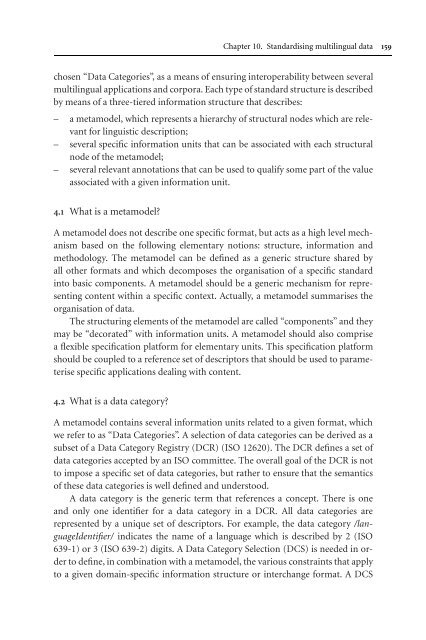Topics in Language Resources for Translation ... - ymerleksi - home
Topics in Language Resources for Translation ... - ymerleksi - home
Topics in Language Resources for Translation ... - ymerleksi - home
- No tags were found...
You also want an ePaper? Increase the reach of your titles
YUMPU automatically turns print PDFs into web optimized ePapers that Google loves.
Chapter 10. Standardis<strong>in</strong>g multil<strong>in</strong>gual data 159chosen “Data Categories”, as a means of ensur<strong>in</strong>g <strong>in</strong>teroperability between severalmultil<strong>in</strong>gual applications and corpora. Eachtypeofstandardstructureisdescribedby means of a three-tiered <strong>in</strong><strong>for</strong>mation structure that describes:– a metamodel, which represents a hierarchy of structural nodes which are relevant<strong>for</strong> l<strong>in</strong>guistic description;– several specific <strong>in</strong><strong>for</strong>mation units that can be associated with each structuralnode of the metamodel;– several relevant annotations that can be used to qualify some part of the valueassociated with a given <strong>in</strong><strong>for</strong>mation unit.4.1 What is a metamodel?A metamodel does not describe one specific <strong>for</strong>mat, but acts as a high level mechanismbased on the follow<strong>in</strong>g elementary notions: structure, <strong>in</strong><strong>for</strong>mation andmethodology. The metamodel can be def<strong>in</strong>ed as a generic structure shared byall other <strong>for</strong>mats and which decomposes the organisation of a specific standard<strong>in</strong>to basic components. A metamodel should be a generic mechanism <strong>for</strong> represent<strong>in</strong>gcontent with<strong>in</strong> a specific context. Actually, a metamodel summarises theorganisation of data.The structur<strong>in</strong>g elements of the metamodel are called “components” and theymay be “decorated” with <strong>in</strong><strong>for</strong>mation units. A metamodel should also comprisea flexible specification plat<strong>for</strong>m <strong>for</strong> elementary units. This specification plat<strong>for</strong>mshould be coupled to a reference set of descriptors that should be used to parameterisespecific applications deal<strong>in</strong>g with content.4.2 What is a data category?A metamodel conta<strong>in</strong>s several <strong>in</strong><strong>for</strong>mation units related to a given <strong>for</strong>mat, whichwe refer to as “Data Categories”. A selection of data categories can be derived as asubset of a Data Category Registry (DCR) (ISO 12620). The DCR def<strong>in</strong>es a set ofdata categories accepted by an ISO committee. The overall goal of the DCR is notto impose a specific set of data categories, but rather to ensure that the semanticsof these data categories is well def<strong>in</strong>ed and understood.A data category is the generic term that references a concept. There is oneand only one identifier <strong>for</strong> a data category <strong>in</strong> a DCR. All data categories arerepresented by a unique set of descriptors. For example, the data category /languageIdentifier/<strong>in</strong>dicates the name of a language which is described by 2 (ISO639-1) or 3 (ISO 639-2) digits. A Data Category Selection (DCS) is needed <strong>in</strong> orderto def<strong>in</strong>e, <strong>in</strong> comb<strong>in</strong>ation with a metamodel, the various constra<strong>in</strong>ts that applyto a given doma<strong>in</strong>-specific <strong>in</strong><strong>for</strong>mation structure or <strong>in</strong>terchange <strong>for</strong>mat. A DCS
















